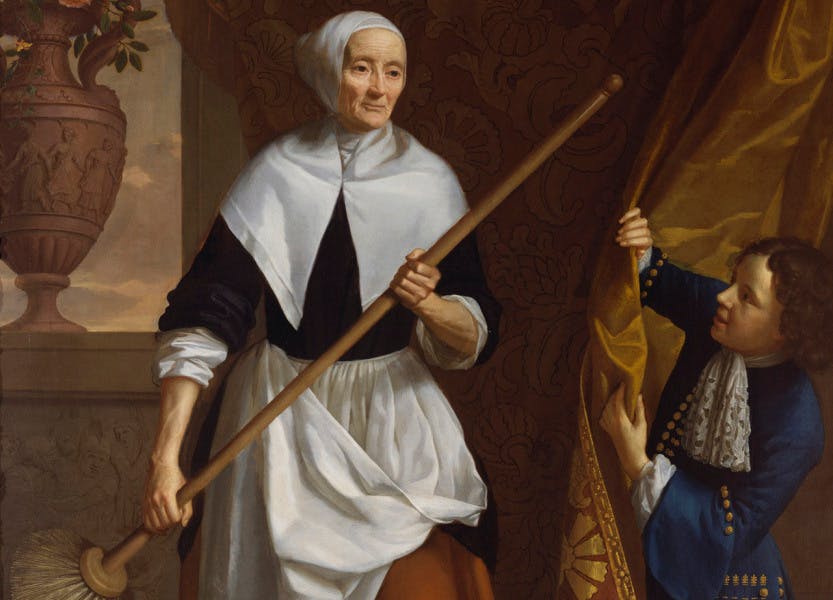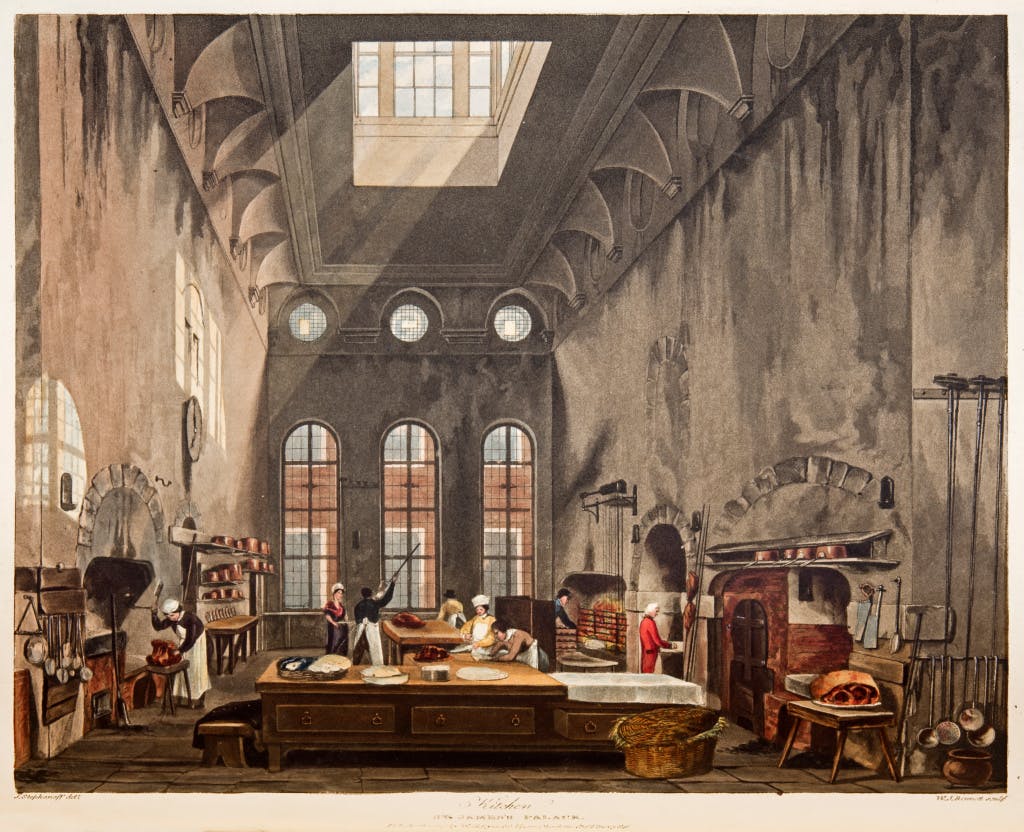Patrick Lamb and William Daniel: A Glimpse into the World of Two Royal Cooks
Date: 11 March 2024
When it came to conjuring up the smell and heat of long-abandoned royal kitchens for Untold Lives, we turned to two cooks’ books which won’t be found on today's kitchen shelves. The first is Patrick Lamb’s Royal Cookery or the Compleat Court-Cook, published just after his death in 1710. Lamb rose through the ranks to become Master Cook to six monarchs and was the first royal cook in England to be promoted in print – a precursor of today’s celebrity chefs.
The second is a hand-written notebook of William Daniel, Master Cook to George II and Queen Caroline. Daniel's book gives us a rare look at a chef working under pressure in a Georgian royal kitchen – missing from printed books like Lamb’s or official records.
Daniel was a large cog in the royal machine, which kept hundreds of people at court well-fed. And, since any respectable-looking person could watch the royals eat on Public Days at the palace, Daniel and his colleagues also played a part in demonstrating the monarchs’ health and wealth.
Inside the King’s Privy Kitchen
Patrick Lamb started in Charles II’s kitchen as a 'child of the pastry' and eventually became the King’s Master Cook. The King’s (Privy) Kitchen had 35 staff – all male, and run under a strict hierarchy dependent on skill and discipline.
Above Lamb was the Chief Clerk of the Kitchen, who planned the daily ‘diet’ according to the lists of dishes for each table from the monarch to the Yeoman of the Guard – all laid out at the beginning of each reign and approved by the monarch. However, it was Lamb and other Master Cooks who varied the daily menu for dinner and supper, responding to the king or queen’s reported preferences, season, location, the royal calendar and sometimes their own innovation.
Under the Master Cook were his second cook; four Yeoman, who made the soups and ragouts (stews); four or five Grooms, who boiled meats for dishes and stock; four to six young men (‘children’), who roasted meats; and five turnbroaches, who turned the roasting spits. Beneath them were scourers and porters, and a doorkeeper. The turnbroaches were known for being rebellious, as their job was physically hard and they were poorly paid.

Image: The title page of Royal Cookery, or, the Complete Cook Book by Patrick Lamb. Royal Collection © His Majesty King Charles III 2024

Image: Food historians working today in the unmodernised early Georgian kitchens at Kew Palace. © Historic Royal Palaces
Working conditions in Lamb and Daniel’s kitchens were hot, noisy and pressured. Even though the Georgians modernised their old palace kitchens, there was little ventilation and no understanding of the hazards of fumes from the wood and charcoal fires. If we want to gain an idea of Lamb and Daniel’s workplace, Henry VIII’s Kitchens at Hampton Court are the best place to go and, surprisingly, remained in use by the household in the Georgian period.
Small wonder perhaps that Lamb lost his temper more than once and was hauled up before the Court of the Greencloth, which dealt with justice within the palaces. In 1690 he excused himself saying, he 'declared his sorrow and regret for having said anything against Mr Isaac (probably the third clerk) and that it proceeded from his passion, which he hoped would be excused in a cook', which might remind you of a well-known celebrity chef today.
Lamb failed to reform and only a few years later was disciplined again for quarrelling with another clerk, which was feared might end in a duel!
Terms and conditions
The rewards for the Master Cook were generous – £150 a year. This was five times what the turnbroaches were paid and included board wages – compensation for not living-in – and salary. They were also entitled to a livery (civil uniform) and the less unappealing, but profitable, ‘lambs heads’, or a cash equivalent whenever they were served to the king.
Lamb proved his talents at four coronation feasts. He was responsible for sourcing all the extra ingredients and other necessities, which undoubtedly boosted his earnings. Whether he intended to profit from his fame by publishing his book in his lifetime, or whether his family saw an opportunity in his leftover papers is not known, but the enterprise certainly established his reputation.
...the Author has not here undertaken to cook out an Art of Gluttony, or to teach the Rich and Lazy, how to grow fatter … but his chief Aim was to represent the Grandeur of the English Court and Nation...
The preface to Patrick Lamb's 'The Complete Cook Book'
At this time food at the English court was dominated by French fashions, and indeed many of Lamb’s rivals came from France. Here was an opportunity to assert the quality of the English royal table, when our two countries remained deadly rivals. Lamb is careful to explain new French culinary terms to his readers, but also includes recipes done 'the English' or even the 'Dutch way'.
A royal recipe
Lamb’s book is illustrated with several royal table plans, but these show plain dishes or ones so common that they rarely feature in his recipes. Here is one relatively simple dish fit for the royal table, based on that most regal of meats, venison.
Venison à la Royale in Blood:
HALF roast it, then stew it, and make a Ragoo [a seasoned stew] to it of Cucumers, Sweet-breads [a type of offal], Asparagus. And so serve it, and Petits [small pastries?] about it, and crisp Parsley.
The Master Cook at work
William Daniel followed a similar career trajectory to Patrick Lamb, but their paths perhaps first crossed when Daniel served in Lamb’s kitchen as a Child of the Kitchen in 1699; he may have witnessed Lamb's temper at first hand. He rose to become Master Cook to Queen Caroline, and finally to the King and Queen.
Daniel’s unique notebook for the royal bills of fare for George II and Queen Caroline gives us a glimpse into the chef's planning of the day's menu. Formal meals consisted of two courses, followed by dessert. Diners could choose from contrasting dishes arranged in a neat pattern. Extra dishes were swapped in mid-meal, known as the Remove or Change.
Although Daniel worked within the bounds of the official daily diet, there is an extraordinary variety over this one year. Not just seasonal menus - including a very familiar Christmas dinner of newly-introduced turkey, mincemeat pieces and plum pudding. But also German dishes to suit our monarchs from Hanover, and some rather homely-sounding food. Among the rich French and traditional English fare – such as hasty pudding- we find mettwurst, a German smoked sausage, sauerkraut, and rather more offal than Mr Lamb served up to Queen Anne.
Like their household itself, there were a surprising number of dishes with international origins, eaten long before they became popular. All part of eating to impress, which rulers have always aspired to do. In Daniel's and his assistant's scrawl, we read vermicelli, 'macaroni cheese' and parmesan cheese from Italy, cream brulé, Frankfurt Pattys (an early hamburger perhaps), tropical pineapples (by then, just about being grown in England) and birds’ nests – for soup perhaps. This could possibly be some of the earliest Chinese food served in England, appropriately enough on 'China plates' which were also imported.
There were also local specialities: rabbits from Turnham Green in West London, lobsters from Chichester in Sussex and frogs. Worst of all, in so many ways, must have been puffin, which thankfully never caught on. Perhaps the King thought it looked good.
If the quantity of food for one couple seems extreme, we should remember that monarchs were publicly judged by the maxim, 'you are what you eat', and that little was left to waste. What wasn't eaten by lower members of the household afterwards might be given away at the kitchen gate. Today we may not like everything that Lamb and Daniel prepared for the royal table, but we can still learn a lot from their efficient use of seasonal, organic, and – mostly – locally produced food, which kept the royals, and so the nation, going.
Sebastian Edwards
Co-curator of 'Untold Lives', Kensington Palace

Untold Lives
Until 27 October 2024
A new exhibition at Kensington Palace, uncovering the forgotten stories of those who worked at the royal palaces over 300 years ago.
More from our blog

The Boy on the Staircase: Peter 'the Wild Boy' from Hanover
11 March 2024
In 1726 the arrival of a 'wild youth' in the Great Drawing Room of St James's Palace caused a London sensation. A boy in his early teens had been found in German woods 'wild, naked… and knowing nobody'. Brought to England, he was nicknamed Peter 'the wild boy'.

'The new Terrors of Death': Dr John Arbuthnot, Queen Anne’s favourite physician
11 March 2024
Dr John Arbuthnot was among the army of medical specialists who were summonsed to serve the Royal family in the 18th century. Arbuthnot is little remembered today, but he was 'the Queen’s favourite physician' — a gentle-mannered confidante to courtiers, politicians, poets, writers and ladies-in-waiting alike.

'Below Stairs' in Sickness, Death and Old Age
29 February 2024
What happened to those who worked in the royal palaces when they fell ill, grew old, or when they died, leaving loved ones behind?



